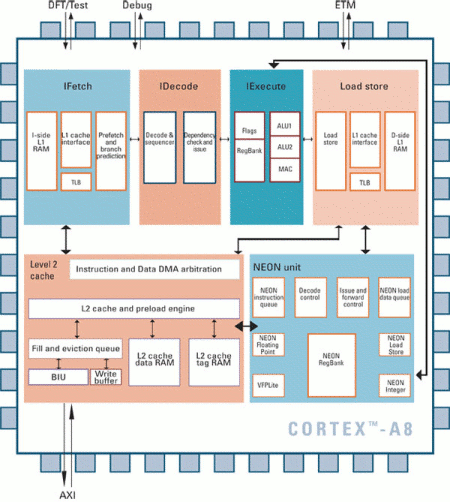Cortex-A8 SoCs use 45nm fabrication
Sep 22, 2009 — by Eric Brown — from the LinuxDevices Archive — 6 viewsSamsung Electronics announced two system-on-chips based on ARM's Cortex-A8 cores, with the S5PC110 aimed at high-end smartphones, and the S5PV210 targeting portable computing devices, such as netbooks. Both SoCs are fabricated with 45nm technology, clocked at 1GHz, capable of 1080p video, and imbued with “intricate low power architectures,” says Samsung.
Samsung is the third major semiconductor vendor after Texas Instruments (OMAP35xx) and Freescale (i.MX51) to offer a system-on-chip (SoC) based on ARM's superscalar Cortex-A8 core (see farther below for more details). Other licensees of the Cortex-A8 include STMicroelectronics, Broadcom, PMC-Sierra, and Panasonic.
TI's OMAP35xx and Freescale's i.MX51 are fabricated using 65nm technology, whereas the S5Px SoCs are said to be fabbed with 45nm technology. In addition, the Samsung chips are clocked at 1GHz, while the OMAP35xx tops out at 600MHz, and the i.MX51 clocks from 800MHz to 1GHz.
Aimed at media-ready mobile devices requiring long battery life, Samsung's new SoCs are said to offer a 3D graphics engine for "sophisticated 3D UI and high-caliber games." The processors also support 1080p video playback and recording, as well as offering an HDMI 1.3 interface, says the company.
A Hummingbird base?
Though Samsung did not confirm it in today's release announcement, its new S5PC110 and S5PV210 appear to be the first result of a September 2008 agreement it signed with Texas-based Intrinsity, Inc., intended to result in low-power processors using the latter's "Fast14" technology. According to Intrinsity, Fast14 technology combines 1-of-N Domino Logic (NDL), custom and semicustom static logic, high-speed memory technology, specialized low-power design techniques, and a design automation platform, adding up to "the best available combination of speed, power and silicon area."
In July, Samsung and Intrinsity announced Hummingbird, touted as "the industry's fastest mobile processor core implementation" of the ARM Cortex-A8 architecture. SoCs based on the Hummingbird will use a 45nm production process, run at 1GHz, and feature extremely low power leakage in sleep mode, the companies said at the time.
According to the companies, SoCs based on the Hummingbird core employ enhanced logic that is "cycle-accurate and Boolean equivalent to the original Cortex-A8 RTL [register transfer level] specification," but is said to replace the typical synthesized static logic with Intrinsity's proprietary NDL. It's claimed that NDL gates can operate 25 to 50 percent faster than static logic gates.
The Hummingbird will also use other power-saving techniques, such as aggressive clock gating, power gating, variable voltage/frequency scaling, optimized Vt selection, and power efficient on-chip communication, the companies say. SoCs based on the Hummingbird core will also offer particularly "low leakage," meaning that little current is being leaked when a device is in sleep mode, the companies say.
3G graphics and HD video
The S5PC110 and S5PV210 both offer 32KB data and 32KB instruction caches, as well as a 512KB L2 cache, says Samsung. Both SoCs are said to offer a "wide variety of interfaces and peripherals," though apart from HDMI, only high-speed USB 2.0 was detailed.
The S5Px SoCs appear to differ only in packaging and memory interfaces. Aimed at small form-factor mobile devices, the S5PC110 is housed in a 0.5mm pitch, 14x14mm FBGA package. This enables package-on-package vertical stacking of low power, multiple chip package (MCP) memory such as OneDRAM, mobile DDR, or LP DDR2, says Samsung.
The netbook-oriented S5PV210, meanwhile, is packaged in a 0.65mm pitch, 17x17mm FBGA package. The SoC also offers a dual-channel 32-bit DDR2 memory interface, says the company.
Samsung did not offer operating system support details about the S5PVx SoCs, but other Cortex-A8 SoCs have supported Linux, Windows, and other major operating systems.
Cortex-A8 background
The ARM Cortex-A8 core architecture, which tops out at 1GHz, was announced in 2005. Based on the ARMv7 instruction set, the core offers a dual-issue, superscalar pipeline that can execute multiple instructions simultaneously, helping it deliver 2,000 DMIPS (Dhrystone MIPS) at 1GHz. The A8 was the first of ARM's processor designs to integrate the company's Neon integer and floating-point pipelines for media and signal processing.

The A8 sports media, security, and Java engines
(Click to enlarge)
Power draw for the Cortex-A8, meanwhile, is claimed to be less than 300mW when implemented using 65nm technology. The A8 also shaves power by supporting traditional static and dynamic management techniques, such as frequency and voltage scaling. In short, the core is claimed to burn as much power as an ARM11 core, while delivering two to three times the performance.
ARM followed up with a Cortex-A9 core, announced in Oct. 2007, which should appear in finished silicon later this year or early next. The Cortex-A9 is promoted as supporting clock speeds over 1GHz and performance of around 2,000 Dhrystone MIPS. The A9 also incorporates ARM's MPCore interconnect technology.
Last week, ARM Holdings announced two dual-core implementations of the Cortex-A9, code-named "Osprey," said to be capable of clock speeds above 2GHz. Osprey evaluation chips should be available in 1Q 2009, says the company.
Stated Kwang Hyun Kim, SVP, strategic marketing team, System LSI Division, Samsung Electronics, "PC-level performance with lower power consumption will become mainstream requirements for advanced mobile devices. Samsung developed S5PC110 and S5PV210 application processors to satisfy these conflicting requirements to enable a new level of user experience not previously possible."
Availability
Customer samples of the S5PC110 and S5PV210 SoCs will be available in December, says Samsung Electronics. More information may eventually be found at Samsung's website, here.
This article was originally published on LinuxDevices.com and has been donated to the open source community by QuinStreet Inc. Please visit LinuxToday.com for up-to-date news and articles about Linux and open source.